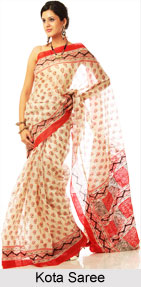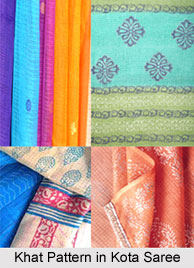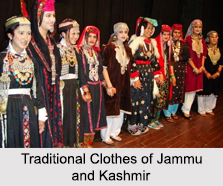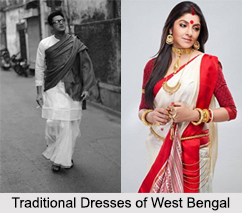 Kota saree is basically created in Kota, Rajasthan and Muhammadabad Gohna, Mau in Uttar Pradesh and its nearby area. Sarees are made of pure cotton and silk. Kota sarees are also called "Kota Doria" which is a super transparent yet stable cotton or cotton-silk weave. This saree is created in a way that the saree display an almost graph like pattern called khats which is a squares formed between the different thicknesses of fibers. These sarees are worn in summer to get relief from the heat of summer. The designs of Kota sarees are so done that it gets a weightless appearance and feel. The Kota sarees are the exclusive sarees of North India and are perfect as a summer wear.
Kota saree is basically created in Kota, Rajasthan and Muhammadabad Gohna, Mau in Uttar Pradesh and its nearby area. Sarees are made of pure cotton and silk. Kota sarees are also called "Kota Doria" which is a super transparent yet stable cotton or cotton-silk weave. This saree is created in a way that the saree display an almost graph like pattern called khats which is a squares formed between the different thicknesses of fibers. These sarees are worn in summer to get relief from the heat of summer. The designs of Kota sarees are so done that it gets a weightless appearance and feel. The Kota sarees are the exclusive sarees of North India and are perfect as a summer wear.
Features of Kota Saree
The fabric of Kota Doria is made up of cotton and silk yarn in different combinations in warp and weft, which are woven in such a fashion that they produce square check patterns in the fabric. These checks are locally known as "Khat" and these are made so skillfully that the fabric becomes transparent, which is a unique characteristic of this wonder hand woven fabric.
History of Kota Saree
Originally, such sarees were called "Masuria" because they were woven in Mysore.
 The weavers were subsequently brought to Kaithoon, a small town in Kota by Rao Kishore Singh, a general in the Mughal army. The weavers were brought to Kota in the late 17th and early 18th century and the sarees came to be known as "Kota-Masuria".
The weavers were subsequently brought to Kaithoon, a small town in Kota by Rao Kishore Singh, a general in the Mughal army. The weavers were brought to Kota in the late 17th and early 18th century and the sarees came to be known as "Kota-Masuria".
Production of Kota Saree
Kota Doria is woven on a traditional pit loom in such a fashion that it produces square checks pattern on the fabric. They smear onion juice and rice paste with a lot of care into the yarn making the yarn so strong that no additional finishing is needed. The process of weaving is supported by a number of activities like pirn winding, warping, dyeing, sizing, etc. The spinning, dyeing and weaving are done by the adept artisans of the region, who are involved in weaving and designing. Basically the sarees are woven in white and later dyed with different vibrant hues. Often the sarees are embellished with zari work in the border.
Industry of Kota Saree
Kota sarees are popularly known as "Masuria" in Kota and "Kota Doria" outside the state. Rajasthan Handloom Development Corporation is taking the lead in producing items other than sarees from the Kota Doria. Kota saris display individuality with a bit of embroidery and border patches, making them totally exclusive.





















